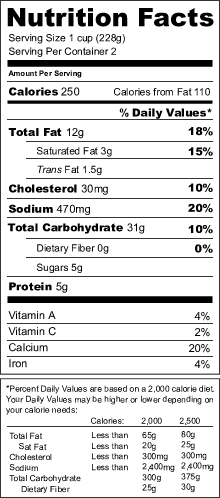How to read a Nutrition facts label
When we are doing the grocery shopping we tend to walk through the aisles and get what ever we like to buy and eat. Then we realize why we put on weight as most of us don’t realize that all the hidden sugars and fats are also in a lot of what we purchase and consume not knowing how much we really are consuming per serve and not aware that our portions are not measured to maintain ourselves in a healthy weight and healthy eating habits. To avaoid all the hard work in wanting to lose all the excess weight that we don’t need, the easy way to get started is to be able to know how to read a nutrition facts label. Whether you’re one to zoom in on total calories or total carbs, you might be missing the real picture. Nutrition facts should be a part of your decision in what to eat or even what to buy. But interpreting the facts requires a bit of know-how, so make sure you are not misleading yourself.
Understand the Power of “Serving Size”
The most important rule is to know your serving size and the number of servings in the package or can. If the labels says “one cup” for serving size and “two servings per container,” that means there are two cups in the whole package. If you know you’ll eat the whole package by yourself, you are going to consume two cups (1 cup x 2 servings/container = 2 cups). That means that you must double all the nutrition facts measurements to know your total intake of each nutrient – the good and the bad. Using the mac and cheese example, eating the whole package means you will have consumed 500 calories, 220 of which are from fat. You will have consumed 24 g of fat, of which 6 g is saturated fat. That’s not exactly a balanced meal to fuel yourself for the day.
The only time you can avoid doing the math is when you eat the exact serving size that is listed. Always compare the listed serving size to how much food you think you’ll eat and compute calories from there. 
Crack the Code in “Percent Daily Value”
Confused by what all those percents really mean? The percents refer to “percent daily value” and they’re a bit trickier to interpret. The FDA bases these percents on a 2000-calorie-a-day diet. The Nutrition Facts footnote gives a scale in grams and milligrams for recommended amounts of fat, cholesterol, sodium, carbs, and fiber based on a 2,500 diet as well as looking at cholesterol on the mac and cheese label, the FDA says that you are getting 30 mg and this is 10% of the recommended amount of cholesterol for a person eating about 2,000 calories per day. (Remember, you’re getting 20% if you ate the whole package.) So how do you know if 10% is a good or bad number?
The magic numbers are 5 and 20%. Anything listed in the percent daily value column that is 5% or less is a low number for nutrients. This is a good range for things that you want to limit (fat, saturated fat, cholesterol, and sodium), but too low for things you want to eat plenty of (fiber, calcium, and vitamins). Anything listed as 20% or more is high. This is a bad range for things that you want to limit (fat, saturated fat, cholesterol and sodium), but a good range for things you want to eat plenty of (fiber, calcium, and vitamins). Use 5 and 20% as benchmarks when interpreting numbers between 6 and 19% (look at what is closer to “high” or closer to “low”).
Look at “Total Fat” on the mac and cheese label. The 18% daily value is close to the high point, but if you ate the whole package, you actually ate 36% of the recommended daily amount of fat (well above our benchmark of 20%!). That amount, coming from just one source of food in a day, contributes a lot of fat to your daily diet. It would leave you 64% (100% – 36% = 64%) of your fat allowance for all other meals, drinks, and snacks you would eat that day.
The percent daily value also offers a great way to watch your diet without completely giving up your favorite foods. For example, if you ate one serving of macaroni and cheese but ensured you had a low fat intake for all other foods you ate that day, you made a successful trade-off. When you really want a food that is high in fat, always balance it with healthy low-fat foods in the same day.
Now that you know this use it and purchase foods that will give you more nutritional value for your daily food intake, happy grocery shopping!

